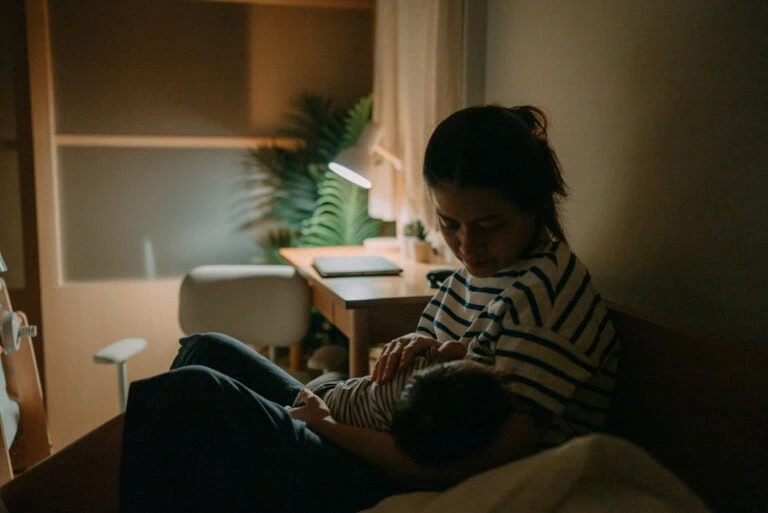If you’ve ever typed into Google, “Why won’t my baby sleep?” you’re not alone. You’re among thousands of other parents/caregivers who are likely as tired as you are. Chances are, if you have gone down the Google rabbit hole at 2:00 a.m. (or asked your pediatrician for sleep advice), you’ve most likely been introduced to a bedtime routine.
A bedtime routine can be a beneficial tool in establishing healthy sleep habits and good sleep hygiene.1 Infants and young children thrive on routine and are comforted by predictability (spoiler alert: most adults are this way, too!). Plus, a young mind is exposed to so much new information daily that it’s reassuring for a child to know they can depend on certain events to have a predictable structure.
Bedtime routines also cue their brains and bodies that sleep is coming. With a predictable bedtime routine, your little one will start recognizing the routine’s order and anticipate what comes next. With enough repetition, this process happens automatically in a very Pavlovian way. A calm and successive routine will also make the onset of sleep come more easily. Imagine if you walked out of your workout, and immediately someone told you that you had to lie down and fall asleep. This would be nearly impossible; the same is true for our little ones. By allowing them some time to unwind, you are making the falling asleep process that much easier.
How to Create a Bedtime Routine
If you’re lost on where to start or how to create an effective bedtime routine for your little one as they grow, don’t worry – I’ll help break it down. But first, here are a few general bedtime routine guidelines:
It Doesn’t Have to Be Long (But It Shouldn’t Be Too Short, Either)
Bedtime routines throughout infancy and early childhood should generally be between 20-30 minutes long and usually involve about 4-5 steps. But don’t set your stopwatch or stress too much about adding activities; this is just a loose frame of reference. If you have fewer steps or it takes a bit longer, that is just fine! However, remember that the bedtime routine’s purpose is to allow your little one some time to unwind and prepare their body for sleep. However, it shouldn’t be too long that it seems to drag on, and it becomes hard to recognize when the end of the routine is approaching.
It Should Be Relaxing and Enjoyable
If your little one hates bath time or cannot stand sitting on your lap while you read book after book, don’t include it in your bedtime routine. No law says you must include certain steps, so find a good balance between what needs to be done (e.g., using the potty or brushing teeth) and what your little one enjoys.
Most of the Routine Should Take Place in Your Child’s Sleep Space
This will help signal to your little one that sleep is imminent and help keep negotiating and horsing around to a minimum.
Bedtime Routines for Newborns, Babies, Toddlers
Bedtime routines can begin immediately, but by the 6-week mark, having a consistent and predictable nighttime pattern can be beneficial.
Newborn Bedtime Routines (0-3 months)
Bedtime routines at this age should always include a full feed as the last step to ensure your baby is falling asleep with a full tummy (which will set you up for a longer stretch of sleep.) Since feedings in the newborn period may take longer than 20-30 minutes, there probably won’t be many more “steps.” A sample routine might include the following:
- Quick bath/washcloth wipe-down
- Lotion/infant massage
- Diaper/PJs
- Full feeding + burp
- Swaddle
- Rocking/cuddles/kisses
Baby Bedtime Routines (4-12 months)
As your baby gets older, sleep associations become incredibly strong. While this makes a predictable routine an excellent tool for easy bedtimes, it can also cause problems in the sleep department if you’re not careful. One of the biggest culprits of sleep struggles is when babies fall asleep while eating. Not only can this set them up for a cycle of frequent night wake-ups, but they are likely falling asleep before they are truly full!
Set your little one up for success by feeding them earlier in the routine. 15-20 minutes won’t impact how long your baby can sleep before they need to eat again, but it can make a difference in helping them sleep through the night. A sample routine might include the following:
- Full feeding
- Bath/brush teeth
- Lotion/massage
- Diaper/PJs/sleep sack
- 1-2 books, lullabies, or nursery rhymes
- Prayers/cuddles/kisses
Young Toddler Bedtime Routines (13-18 months)
Once your little one is primarily on solid foods, they likely will not need a full feeding as a part of their bedtime routine. While many nursing mothers will continue to nurse as part of the routine purely out of comfort and pleasure (which I applaud and encourage if it works for you), formula-feeding parents are usually weaning off formula and working on dropping the bottle around this age anyway. The bedtime routine’s content will likely be very similar to the months prior, but you may be able to include some alternative types of 1:1 time in the form of more bedtime stories or singing together. A sample routine might consist of the following:
- Bath
- Brush teeth
- Diaper/PJs/sleep sack
- 2-3 books
- Songs
- Prayers/Cuddles/Kisses
Older Toddler and Preschooler Bedtime Routine (18 months-3 years)
The older your little one gets, the more important a consistent bedtime routine becomes. With budding autonomy and a penchant for negotiation, older toddlers and preschoolers are masters at bedtime stalling tactics. With a firm bedtime routine (especially one consistently followed for their entire life), the chances of bedtime battles decrease significantly. However, it can help to allow your little one some benign choices regarding certain things. For example, you may let them pick which bath toys they’d like to play with, choose their PJs, or select three books to read. This can help mitigate some of the struggles around the non-negotiables (like going to bed). A sample routine might include the following:
- Bath
- Brush teeth
- PJs
- 3-4 books
- Use the potty
- Prayers/Cuddles/Kisses
Bedtime routines can be one of the greatest sleep tools in your tool belt. If your family does not already have a bedtime routine, these guidelines will help. Cheers to great sleep for the whole family!













































